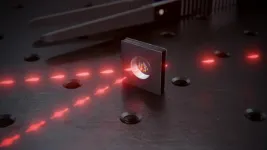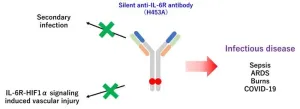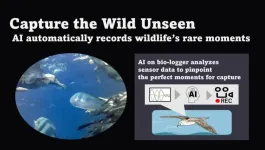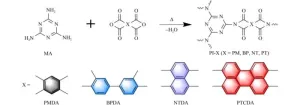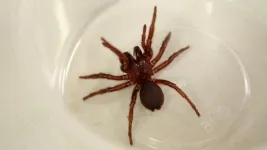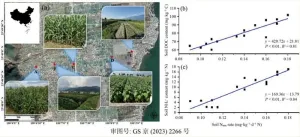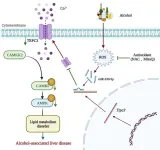(Press-News.org) The pioneering research of Dr Yiliang Ding investigating the structure and function of RNA in living cells has been recognised with a major award.
Yiliang a group leader at the John Innes Centre, is among nine recipients of the 2024 Blavatnik Awards for Young Scientists in the UK, announced today by the Blavatnik Family Foundation and The New York Academy of Sciences.
The awards recognise research that is transforming medicine, technology, and our understanding of the world across three categories: Chemical Sciences, Physical Sciences & Engineering, and Life Sciences.
Yiliang is the first UK plant scientist to receive a Blavatnik Award, an accolade which lends global focus to the innovative work of her group at the John Innes Centre.
“This is a great personal accolade, an honour for my group and the John Innes Centre. It's wonderful that the global community has recognised the importance of plant science in trying to solve the critical challenges of feeding the world, improving crop yields, and combatting plant health threats,” she said.
The Ding group pioneers innovative methods of profiling the structure of RNA inside living cells, providing a springboard for the global use of RNA structure-guided therapeutics for human health and crop improvement.
Professor Graham Moore, Director of the John Innes, said: “Yiliang’s research is world-leading and it is wonderful that she has been recognised by the Blavatnik Foundation with this award. Yiliang and her team push the boundaries of what we know about RNA, developing tools and techniques to unravel this fascinating and vital area of biology. Their fundamental scientific discoveries, and their dedication to translating this into real world solutions epitomises the role of the John Innes Centre.”
RNA is a fundamentally important molecule throughout all organisms, including bacteria, plants, animals, and viruses.
Long known as a crucial part of the central dogma of cellular biology, where DNA is transcribed into RNA, that produces proteins.
It is often represented as a single stranded “skinny” molecule, but thanks to the work of the Ding group and an international research community, we are discovering the complex, dynamic structures and shapes that RNA can form, and the importance of these structures in regulating diverse biological processes.
Yiliang and her team have developed methods to profile and analyse RNA in living cells which has led to increased structural understanding of this intriguing molecule. These methods are already being applied in RNA-based therapies for both human and plant viruses.
The research team is also designing small anti-viral molecules to treat plant viruses and other plant pathogens, with the potential for exciting applications in agriculture.
There are well over 2000 plant viruses that severely impact plant health and one example of the application of Yiliang’s research is in tackling Beet Viruses, a major threat to sugar beet production across the East of England and throughout Europe.
Beet Yellows Virus (BYV) causes Virus Yellows disease that underlies up to 50% yield losses in root crops. Beet mild yellowing virus (BMYV) causes another 22% yield loss.
Previously BYV was controlled using pesticides, primarily neonicotinoids, which have been withdrawn from the market because they are harmful to humans, insects, and the environment. Now, the virus goes unchecked in the field and is a threat to the production of root crops. The Ding group and collaborators have developed a novel anti-viral solution to this disease that is environmentally friendly, safe, sustainable, and effective.
Using novel technologies to capture the RNA structures of the sugar beet virus, they designed the anti-viral small molecules to clean out the plant virus.
Tests have shown 95% efficiency in cleaning the virus from sugar beet plants and the anti-viral strategy could be widely applied to treat other plant viruses.
The technology is being carried forward in collaboration with industrial partners as part of the spinout company RNAshield.
About the 2024 Blavatnik Awards for Young Scientists in the UK
Dr Ding, a group leader at the John Innes Centre, is among nine recipients of the 2024 Blavatnik Awards for Young Scientists in the UK, announced today by the Blavatnik Family Foundation and The New York Academy of Sciences.
The grants, totaling £480,000, recognise research that is transforming medicine, technology, and our understanding of the world across three categories: Chemical Sciences, Physical Sciences & Engineering, and Life Sciences.
Now in their seventh year, the Awards are the largest unrestricted prizes available to UK scientists aged 42 or younger donating £3.3 million to scientists across UK academia since their inception.
Internationally recognised by the scientific community, the Blavatnik Awards for Young Scientists are instrumental in expanding the engagement and recognition of young scientists and provide the support and encouragement needed to drive scientific innovation for the next generation.
Ends
END
John Innes Centre researcher honored with prestigious Blavatnik award
2024-01-17
ELSE PRESS RELEASES FROM THIS DATE:
Mass-producible miniature quantum memory
2024-01-17
Researchers at the University of Basel have built a quantum memory element based on atoms in a tiny glass cell. In the future, such quantum memories could be mass-produced on a wafer.
It is hard to imagine our lives without networks such as the internet or mobile phone networks. In the future, similar networks are planned for quantum technologies that will enable the tap-proof transmission of messages using quantum cryptography and make it possible to connect quantum computers to each other.
Like their conventional counterparts, such quantum networks require memory elements in which information can be temporarily stored ...
A new targeted treatment calms the cytokine storm
2024-01-17
Osaka, Japan – Cytokines are chemical messengers that help the body get rid of invading bacteria and viruses, and control inflammation. The body carefully balances cytokines because they help keep the immune system healthy. However, this balance is upset if the immune system overreacts. A serious infection or a severe burn can unleash a cytokine storm in the body. During the storm—also called cytokine release syndrome (CRS)—the body produces too many cytokines, leading to life-threatening inflammation.
Interleukin-6 (IL-6) is a key cytokine in the storm because it helps to drive the inflammation that damages ...
Tiny AI-based bio-loggers revealing the interesting bits of a bird’s day
2024-01-17
Osaka, Japan – Have you ever wondered what wildlife animals do all day? Documentaries offer a glimpse into their lives, but animals under the watchful eye do not do anything interesting. The true essence of their behaviors remains elusive. Now, researchers from Japan have developed a camera that allows us to capture these behaviors.
In a study recently published in PNAS Nexus, researchers from Osaka University have created a small sensor-based data logger (called a bio-logger) that automatically detects and records video of infrequent behaviors in wild seabirds without supervision by researchers.
Infrequent behaviors, such as diving into the water for food, can ...
SDG-washing found among Canada's top companies
2024-01-17
Canada's biggest companies often speak of their plans to be more sustainable, but a new study found corporations aren't fully backing up those commitments.
A team of University of Waterloo researchers concluded that corporate investing in communities fell despite an increase in companies committing to the United Nation's Sustainable Development Goals (SDGs) over the last decade.
Researchers investigated the community investment of Canada's 58 leading private-sector companies as a percentage of their net profit after tax to determine whether introducing SDGs created ...
Enhanced photoelectrochemical water splitting with a donor-acceptor polyimide
2024-01-17
Polyimide (PI) has emerged as a promising organic photocatalyst owing to its distinct advantages of high visible-light response, facile synthesis, molecularly tunable donor-acceptor structure, and excellent physicochemical stability. However, the synthesis of high-quality PI photoelectrode remains a challenge, and photoelectrochemical (PEC) water splitting for PI has been less studied.
A research group of Huiyan Zhang and Sheng Chu from Southeast University prepared PI films by a ...
Spider venom heart drug a step closer
2024-01-17
A spider venom molecule being investigated by a University of Queensland team has met critical benchmarks towards becoming a treatment for heart attack and stroke.
Associate Professor Nathan Palpant and Professor Glenn King from UQ’s Institute for Molecular Bioscience have previously shown that the drug candidate Hi1a protects cells from the damage caused by heart attack and stroke.
Dr Palpant said a subsequent study has put the drug through a series of preclinical tests designed to mimic real-life treatment scenarios.
“These tests are a major step towards helping us understand how Hi1a would work ...
Is soil nitrogen mineralization important in agricultural intensive areas?
2024-01-17
Soil nitrogen mineralization (Nmin) is a key process that converts organic N into mineral N that controls soil N availability to plants. However, regional assessments of soil Nmin in cropland and its affecting factors are lacking, especially in relation to variation in elevation. Nitrogen is an essential nutrient for crops but mineral N in soil, the only form that can be absorbed and used by crops, represents only about 1% of total soil N. Although N fertilization is commonly a necessary method for supplying N to crops, N release due to excess N fertilizer in the environment ...
Hepatic TRPC3: an emerging regulator of alcohol-associated liver disease
2024-01-17
Excessive alcohol intake is strongly associated with alcohol-associated liver disease (ALD) which accounts for 25% and 30% of deaths from cirrhosis and hepatocellular carcinoma. Impairment of Ca2+ influx and Ca2+-mediated signaling in ALD suggests that Ca2+ channels are important in ALD pathological progression.
TRPC (transient receptor potential cation channel protein C) is an evolutionarily conserved non-selective cation channel protein primarily located in the cell membrane with six transmembrane segments. So far four TRPC subfamilies have been identified, categorized into TRPC1, TRPC2, TRPC4/5, and TRPC3/6/7. Among them, TRPC3 is the most well-studied ...
USC Stem Cell study throws our understanding of gene regulation for a loop
2024-01-17
The blueprint for human life lies within the DNA in the nucleus of each of our cells. In human cells, around six and a half feet of this genetic material must be condensed to fit inside the nucleus. DNA condensation is not random. To function properly, the genetic material is highly organized into loop structures that often bring together widely separated sections of the genome critical to the regulation of gene activity. In a new paper published in Nature Communications, USC Stem Cell scientists from the laboratory ...
A manned submersible found a fault scarp of the 2011 Tohoku-oki megaquake in the Japan Trench
2024-01-17
Niigata, Japan – On September 4, 2022, a geologist Hayato Ueda in Niigata University boarded a submarine vehicle with a pilot Chris May and had a dive into the Japan Trench within the epicenter area of the 2011 Tohoku-oki megaquake, which caused the devastating tsunami disaster. On the 7,500 m deep trench bottom, they found a 26 m high nearly vertical cliff on the eastern slope of a 60 m high ridge. Previous bathymetric surveys from the sea surface have revealed that the ridge did not exist before, and appeared just after the megaquake ...

